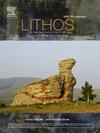Compositional diversity of continental arc magmatism caused by variable degrees of mantle melting: A Gangdese case study
IF 2.9
2区 地球科学
Q2 GEOCHEMISTRY & GEOPHYSICS
引用次数: 0
Abstract
Compositional diversity of magmatism in continental arcs is common and can be collectively attributed to the combination of intra-crustal and extra-crustal processes, but distinguishing their relative contributions remains a challenge. This study investigates processes controlling the compositional diversity in the ca. 220–150 Ma intrusive rocks from the central Gangdese arc (88–92°E) in southern Tibet. New and published zircon Hf isotopic data reveal that assimilation with enriched crustal materials is insignificant for these rocks, but is evident for the coeval intrusive rocks from the eastern Gangdese arc (92–94°E). Our comprehensive dataset reveals progressive increases in highly incompatible elemental (HIEs; e.g., Cs and Rb) concentrations and Rb/Sr ratios in the basaltic rocks from ca. 220 to 150 Ma, coinciding with an increase in crustal thickness from ∼25–30 km to ∼35–40 km and the progressive waning of arc magmatic intensity during this time period. This temporal trend, coupled with the similar HIE enrichment trends recorded by the intrusive rocks from the Kohistan arc, suggest that the decreasing degrees of mantle melting due to progressive mantle cooling played a primary control on the compositional diversity. This work provides a way to trace how varying degrees of mantle melting, in addition to intra-crustal processes, impact the compositional diversity of continental arc magmatism.
求助全文
约1分钟内获得全文
求助全文
来源期刊

Lithos
地学-地球化学与地球物理
CiteScore
6.80
自引率
11.40%
发文量
286
审稿时长
3.5 months
期刊介绍:
Lithos publishes original research papers on the petrology, geochemistry and petrogenesis of igneous and metamorphic rocks. Papers on mineralogy/mineral physics related to petrology and petrogenetic problems are also welcomed.
 求助内容:
求助内容: 应助结果提醒方式:
应助结果提醒方式:


